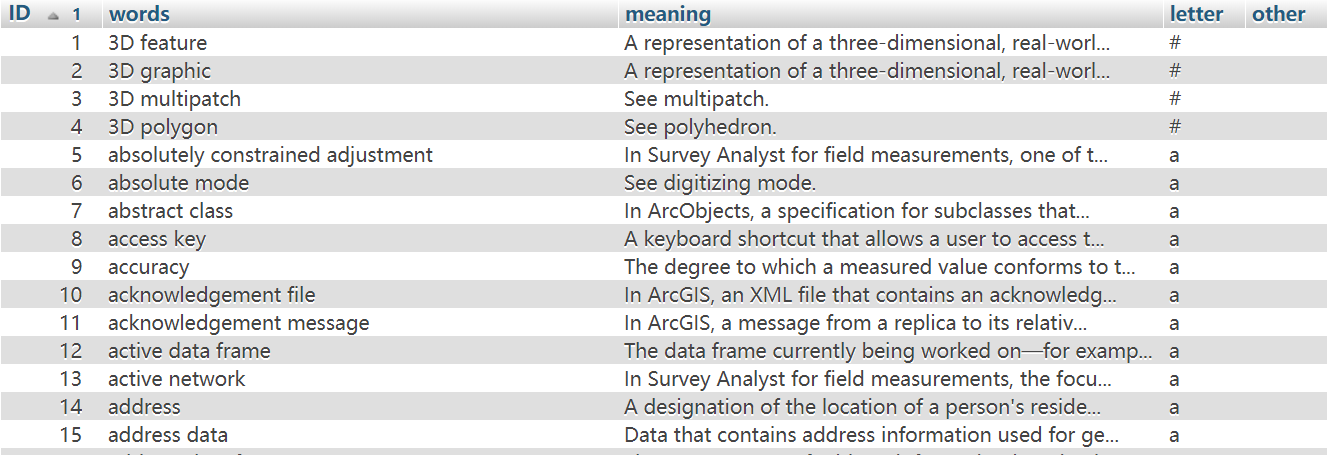今日工作:資料庫連接、數據寫入 一、資料庫連接:使用了pymysql庫 二、數據寫入 代碼部分結束,雖然今天的代碼看起來又少又容易,但sql語句可真是廢了不少力氣。 最終資料庫成果,總共1729條數據: ...
今日工作:資料庫連接、數據寫入
一、資料庫連接:使用了pymysql庫
from G2_dataClean import defList import pymysql db = pymysql.connect(db='gisdictionary',charset='UTF8') cursor = db.cursor()
二、數據寫入
countId = 1 #ID欄位 for i in range(0,len(defList)): alpha = defList[i][1][0:1].lower() #alpha即letter欄位,為單詞首字母。這一步截取出首字母並.lower()小寫。 if not(alpha.isalpha()): #判斷首字母是否為a-z字母,如果不是a-z,則分配'#'給它。 alpha = '#' sql = '''INSERT INTO GISAZ(ID,WORDS,MEANING,LETTER)VALUES(%s,'%s',"%s",'%s');'''%(countId,pymysql.escape_string(defList[i][1]),pymysql.escape_string(defList[i][0]),alpha) countId += 1 cursor.execute(sql) try: db.commit() except Exception: print("發生錯誤",Exception) #不會捕獲mysql的warning警告,Try...Except只捕獲Error錯誤。 db.rollback() #回滾事務 finally: db.close()
代碼部分結束,雖然今天的代碼看起來又少又容易,但sql語句可真是廢了不少力氣。
#核心語句 #sql = '''INSERT INTO GISAZ(ID,WORDS,MEANING,LETTER)VALUES(%s,'%s',"%s",'%s');''' #%(countId,pymysql.escape_string(defList[0][1]),pymysql.escape_string(defList[0][0]),alpha) #cursor.execute() #db.commit() #db.close() #0、核心語句調試了很久,最終使用#三層引號、#%s、#pymysql.escape_string()的方式集合完成了sql語句的撰寫; #pymysql.escape_string()會將數據值string中的 單引號等有意義的符號 通過 多層轉義 的方式取消對語句的影響; #能成功的兩種相同效果的無%s語句:(不必深究,下次要用時再根據這次的經驗嘗試即可) #(一)'''INSERT INTO GISAZ(ID,WORDS,MEANING,LETTER)VALUES(1,'3D feature',"A representation of a three-dimensional, #real-world object in a map or scene, with elevation values (z-values) stored within the feature\\'s geometry. Besides geometry, #3D features may have attributes stored in a feature table. In applications such as CAD, 3D features are often referred to #as 3D models.",'3');''' #(二)'INSERT INTO GISAZ(ID,WORDS,MEANING,LETTER)VALUES(1,\'3D feature\',"A representation of a three-dimensional, #real-world object in a map or scene, with elevation values (z-values) stored within the feature\\\'s geometry. Besides geometry, #3D features may have attributes stored in a feature table. In applications such as CAD, 3D features are often referred to #as 3D models.",\'3\');' #參考文章:https://blog.csdn.net/qq_36622490/article/details/87455903 #1、下麵這句SQL刪除了相同id的行數據,但是沒能保留住其中id最小的那一條行數據;網上方法嘗試數次未能成功,報sql語法錯誤:delete from cqssc where id in (select id from (select id from cqssc where expect in (select expect from cqssc group by expect having count(expect)>1) and id not in (select min(id) from cqssc group by expect having count(expect)>1)) as tmpresult) #delete from gisaz where id in (select id from (select id from gisaz where ID in (select ID from gisaz group by ID having count(ID)>1)) as tmpresult) #參考文章:https://www.cnblogs.com/jdbeyond/p/8157224.html #2、已在Letter列將所有首字母小寫 #3、初次插入數據我選擇分3次進行,犯下了重置countId的錯誤;要註意countId是ID欄位,不能重置進而引起ID重覆。 #4、暫時在數據表中空置了一列other,打算用其放置圖片,或是為"See xxxxxx"等meaning創造通往其他詞條的超鏈接(資料庫內大概有類似功能)。 #5、(無傷大雅,meaning的資料庫類型設置了為text並且沒有設置長度)在phpadmin中暫時沒有找到完成顯示meaning數據的方法,現在都是兩條如"In ArcGIS, a message from a replica to its relativ..."和"原始長度207"的顯示; #6、(Warning!)部分Words的長度超過了預設的varchar(20),造成部分詞語名稱不全。只得修改表結構,重新寫入數據。varchar(40)也不夠,應該去寫一個找出defList[n][1]最大值的程式。 #未來再做資料庫還是得先確定最大長度再建表;通過簡單的程式'max=len(defList[0][1]);for i in range(0,1729):{if(len(defList[i][1])>max):{max=len(defList[i][1])}}'得到最大值為50,故設定varchar(60)。
#7、考慮是否要把後119條數據按照首字母重新洗入前面的數據中。
最終資料庫成果,總共1729條數據:




